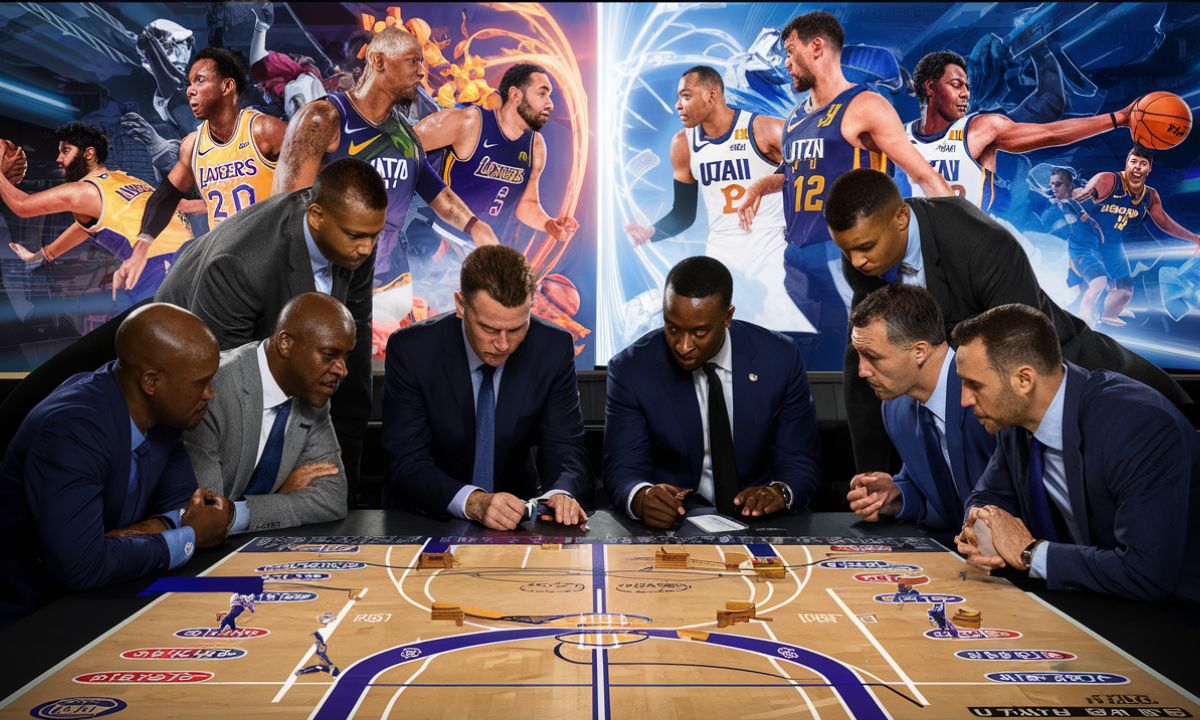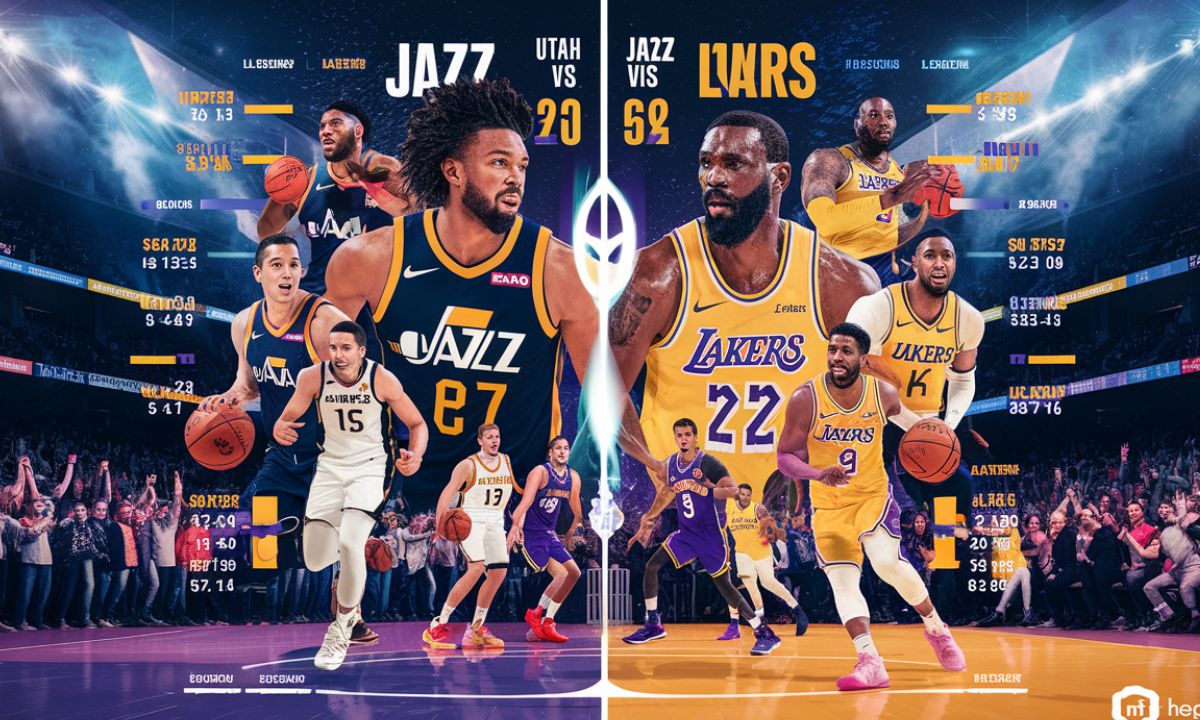Utah Jazz vs. Lakers Match Player Stats: In the intense arena of NBA competition, every possession holds significance, and each player’s impact is crucial.
When the Utah Jazz went head-to-head with the Lakers in their latest clash, the numbers alone didn’t capture the full picture.
This in-depth analysis delves into the key player stats that influenced the outcome, focusing not only on top scorers but also on vital efficiency metrics, defensive efforts, and game-changing plays that ultimately decided the winner.
Opening Storyline: More Than Just Another Game
The clash between the Utah Jazz and the Los Angeles Lakers on March 24, 2025, was not just another routine NBA game. Anticipation filled the air as fans gathered to witness the Lakers, a powerhouse in the league, face off against a determined Jazz team in a rebuilding phase.
The stakes were heightened by the possibility of LeBron James reaching a significant career milestone, adding excitement to an already thrilling matchup.As the game progressed, it became evident that each team brought a unique style to the court.
The Lakers relied on their seasoned veterans, showcasing their experience and skill. In contrast, the Jazz displayed their depth and emerging talent, providing a glimpse into their future potential. The final score, 117-103 in favor of the Lakers, belied the intense competition, with multiple lead changes and momentum swings that kept fans captivated.
Star Power: LeBron & Markkanen Face-Off
The most talked-about matchup of the evening was between LeBron James and Lauri Markkanen. Both players had standout performances that highlighted their distinct roles in their respective teams.
| Player | PTS | REB | AST | STL | BLK | FG% | 3P% | +/- |
| LeBron James | 28 | 9 | 12 | 2 | 1 | 58.8% | 40.0% | +18 |
| Lauri Markkanen | 25 | 11 | 2 | 0 | 1 | 47.4% | 33.3% | -8 |
LeBron’s impact was particularly pronounced in the third quarter, where he scored 14 points and assisted on five others. He successfully exploited mismatches against smaller defenders, showcasing his elite basketball IQ.
Meanwhile, Markkanen made a significant early impact with 17 points in the first half, but the Lakers’ defensive adjustments stifled his effectiveness later in the game.
Lakers’ Frontcourt vs. Jazz Interior Defense

The interior battle between Anthony Davis and Walker Kessler proved pivotal. Davis’ versatility overwhelmed Kessler, who struggled with foul trouble throughout the game.
| Team | Points in Paint | Second Chance Points | Fast Break Points |
| Lakers | 54 | 16 | 23 |
| Jazz | 40 | 12 | 14 |
Davis finished with 23 points, 15 rebounds, and 4 blocks, significantly impacting the game on both ends of the floor. The Lakers dominated the paint, shooting 68.4% at the rim, while the Jazz managed only 52.1%. This disparity in the paint was a crucial factor in the Lakers’ victory.
Guard Play: Critical Ball Movement & Scoring
The guard play highlighted contrasting styles and effectiveness. D’Angelo Russell of the Lakers orchestrated the offense efficiently, while the Jazz’s Collin Sexton and Jordan Clarkson faced challenges in ball security.
| Guard | PTS | AST | TO | AST/TO | 3PM-A | STL |
| D’Angelo Russell (LAL) | 18 | 9 | 2 | 4.5 | 4-9 | 1 |
| Austin Reaves (LAL) | 14 | 6 | 1 | 6.0 | 2-5 | 2 |
| Collin Sexton (UTA) | 16 | 4 | 3 | 1.3 | 1-5 | 0 |
| Jordan Clarkson (UTA) | 19 | 3 | 4 | 0.75 | 3-8 | 1 |
Russell’s performance, combined with Reaves’ contributions, showcased the Lakers’ depth in the backcourt. In contrast, the Jazz struggled with turnovers, which directly affected their scoring opportunities.
Read More:Jersey Express Lucy Wells 2025: Overcoming Obstacles, Attaining Success
Bench Impact: Depth Difference
While the starters laid the groundwork, bench contributions were significant in shaping the game’s outcome. The Lakers’ bench outscored the Jazz’s 34-28, with critical performances from Rui Hachimura and Lonnie Walker IV.
| Bench Player | Team | MIN | PTS | REB | +/- |
| Rui Hachimura (LAL) | LAL | 22 | 12 | 5 | +7 |
| Lonnie Walker IV (LAL) | LAL | 18 | 10 | 2 | +6 |
| Kelly Olynyk (UTA) | UTA | 20 | 9 | 6 | -8 |
| Talen Horton-Tucker (UTA) | UTA | 24 | 11 | 3 | -13 |
The Lakers’ bench maintained leads during critical stretches, demonstrating their ability to perform under pressure. Conversely, the Jazz’s bench struggled defensively, contributing to a significant minus in plus/minus stats.
Game-Changing Sequences
Several key sequences dramatically shifted the momentum of the game. The Lakers’ third-quarter surge, led by LeBron and Davis, established a commanding lead that the Jazz could not overcome.
- Lakers’ Third-Quarter Run: A decisive 16-6 run fueled by excellent shooting and strong defense forced the Jazz into four turnovers.
- Jazz’s Failed Comeback Attempt: Utah cut the lead to eight points but missed several shots, allowing the Lakers to extend their advantage.
- Russell’s Momentum-Shift: Back-to-back three-pointers from Russell reestablished a double-digit lead, deflating the Jazz’s momentum.
These pivotal moments illustrate how sudden bursts of efficiency can dictate the outcome of a game.
Advanced Metrics Spotlight
Analyzing advanced metrics such as Player Efficiency Rating (PER) and True Shooting Percentage (TS%) provides deeper insights into player impact.
| Player | PER | TS% | Net Rating | Usage % |
| LeBron James | 31.2 | 64.8% | +18.3 | 28.4% |
| Anthony Davis | 28.7 | 61.2% | +14.9 | 24.1% |
| D’Angelo Russell | 20.4 | 58.7% | +12.7 | 22.8% |
| Lauri Markkanen | 23.8 | 55.2% | -6.8 | 26.7% |
| Jordan Clarkson | 16.3 | 52.1% | -12.4 | 25.0% |
LeBron and Davis led the Lakers in efficiency, showcasing their crucial roles in both scoring and playmaking. The Jazz’s metrics indicated a need for improvement, particularly in clutch situations.
Coaching Strategy: The Stats Behind Decisions

Coaching strategies significantly impacted the game’s outcome. The Lakers’ effective timeout management and substitution patterns allowed for fresher legs during crucial moments.
- Timeout Effectiveness: The Lakers outscored the Jazz 22-14 after timeouts.
- Substitution Patterns: The Lakers maintained fresher players, allowing for more effective late-game execution.
- Defensive Adjustments: Shifting Davis to guard Markkanen in the second half proved decisive, limiting Markkanen’s effectiveness.
These coaching decisions highlighted the tactical battle that shaped the game.
Frequently Asked Questions
What was the final score of the Jazz vs. Lakers game?
The Lakers won the game with a score of 117-103.
How did LeBron James perform in the match?
LeBron scored 28 points, had 9 rebounds, and 12 assists with a shooting percentage of 58.8%.
Who was the standout player for the Jazz?
Lauri Markkanen led the Jazz with 25 points and 11 rebounds.
What was the impact of Anthony Davis on the game?
Davis contributed 23 points, 15 rebounds, and 4 blocks, significantly influencing the paint battle.
How did the bench players perform?
The Lakers’ bench outscored the Jazz bench 34-28, with Rui Hachimura and Lonnie Walker IV leading the charge.
What were the critical game-changing moments?
Key moments included the Lakers’ third-quarter surge and Russell’s back-to-back three-pointers.
How did the teams compare in shooting percentages?
The Lakers shot 48.3% from the field, while the Jazz shot 41.7%.
What was the significance of fast-break points in the game?
The Lakers outscored the Jazz in fast-break opportunities, capitalizing on Utah’s turnovers.
How did coaching strategies impact the game?
Effective timeouts and defensive adjustments by the Lakers proved crucial in maintaining leads.
What are the implications of this game for both teams?
The victory boosts the Lakers’ playoff aspirations, while the Jazz can take positives from their competitive performance.
Conclusion
The matchup between the Utah Jazz and Los Angeles Lakers revealed the intricacies of NBA competition. While the final score indicated a clear victory for the Lakers, the underlying player stats tell a more complex story.
LeBron James and Anthony Davis demonstrated their elite abilities, impacting the game in multiple ways.For the Jazz, despite the loss, the performance of Lauri Markkanen and their overall competitiveness hints at a promising future.
As both teams move forward, the lessons learned from this game will be invaluable in their respective journeys. The statistical insights highlight not only the strengths of the Lakers but also areas for growth for the Jazz, making this matchup a key moment in the season.
Read More info:petwellness786.info












